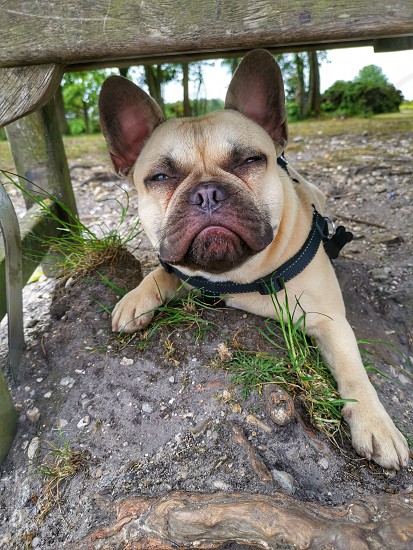Key Takeaways
Introducing a gentle leader harness to your French Bulldog can transform your walks into enjoyable experiences.
Choosing the right harness is crucial; it should be comfortable, secure, and appropriate for your Frenchie’s size.
Positive reinforcement is key to successful leash training and building a trusting relationship with your dog.
Start with short, focused training sessions and gradually increase the complexity as your dog becomes more comfortable.
Address common challenges like pulling and overexcitement with patience and consistent training techniques.
What You’ll Gain from Leash Training
Think of leash training not just as a task, but as an investment in your shared future. By leash training your French Bulldog, you’re setting the stage for stress-free walks, enhanced safety, and a deeper bond with your furry friend. You’ll enjoy peaceful strolls, knowing that your Frenchie is well-behaved and responsive to your cues.

Equip Yourself: Essential Tools for Success
Before diving into the training process, it’s important to gear up with the right tools. A gentle leader harness is a fantastic choice for French Bulldogs, as it offers control without strain on their compact bodies. Additionally, stock up on treats for rewards, a sturdy leash, and loads of patience – your most important tool of all.
Choosing the Right Gentle Leader Harness
French Bulldogs, with their unique physique, require a harness that fits just right. A gentle leader harness is ideal because it discourages pulling without choking, and it places pressure on the back of the neck rather than the throat. This is vital for Frenchies, given their predisposition to breathing difficulties.
Features to Look For
When selecting a gentle leader harness for your French Bulldog, here are some features to keep an eye out for:
Adjustability: A snug fit is essential, so choose a harness with plenty of adjustable points.
Comfort: Look for padded straps to ensure your Frenchie’s comfort during walks.
Size: Make sure the harness is specifically designed for small breeds with short snouts.
Quality: A durable harness will withstand the test of time and energetic Frenchies.
Fitting the Harness Perfectly
Fitting the harness properly is as important as the harness itself. Ensure that you can fit two fingers under any strap. This is tight enough to be secure, but loose enough to be comfortable. Always follow the manufacturer’s instructions for the best fit, and watch your Frenchie’s body language – they’ll let you know if something’s not right.

“Angry dog doesn’t want to walk anymore …” from community.snapwire.co and used with no modifications.
Introducing Your French Bulldog to the Gentle Leader
The first encounter your Frenchie has with their new harness should be a positive one. Let them sniff it and explore it with their senses. You might even place it near their bed or feeding area for a few days before attempting to put it on. This familiarity will ease the transition when it’s time to wear it.
The Initial Meeting: Harness and Your Pup
When it’s time to introduce the harness, do so in a calm environment. Distract your pup with treats or their favorite toy as you gently place the harness on them. If they seem uncomfortable or try to wriggle out, it’s okay to take a break and try again later. Patience is your ally.
Pairing the Harness with Positive Reinforcement
Once the harness is on, it’s time for positive reinforcement. If your Frenchie stands still or walks with the harness without fussing, shower them with praise and treats. This association between the harness and good things will pave the way for successful leash training.
Leash Training Fundamentals
Leash training is about more than just teaching your dog to walk without tugging—it’s about communication and mutual respect. The goal is to create a walking partnership where both you and your Frenchie are comfortable and in sync. Remember, training is not a one-time event but a continuous process.
Building Trust and Confidence
Building trust starts with consistent, gentle guidance. Your French Bulldog needs to know that you’re the leader, and the leash is a means of communication, not punishment. Use calm, assertive energy to guide your dog, and always reward positive behavior. This will boost their confidence and reinforce your bond.
Trust also means understanding your dog’s limits. If your Frenchie is scared or uncomfortable, pushing too hard can damage the trust you’ve built. Instead, recognize these moments and give your dog time to adjust at their own pace.
Maintaining Focus and Control
Maintaining focus is crucial, especially for a breed as playful and curious as the French Bulldog. Keep training sessions short and engaging. Use commands consistently and combine verbal cues with leash signals. Your dog will learn to look to you for guidance, which helps maintain control during walks.
Control doesn’t mean being harsh; it means guiding your dog to make the right choices. A gentle leader harness can help with this, as it directs your Frenchie in a way that’s natural for them without causing discomfort.
Step-by-Step Leash Walking Technique
Effective leash walking is a dance between you and your dog, one that requires practice and patience. Start by letting your Frenchie wear the harness around the house. This desensitizes them to the feeling and makes the transition to outdoor walks smoother.
Start with Short Sessions
Begin with short, five-minute walks in a familiar, low-distraction area. Keep the leash loose; if your Frenchie pulls, stop and call them back to you. When they return, reward them and continue walking. This reinforces the idea that walking nicely means the walk continues, while pulling means it stops.
Gradually Increase Difficulty and Duration
As your dog gets the hang of it, gradually increase the length of your walks. Introduce new environments with more distractions. Always be prepared to go back a step if your Frenchie starts to struggle; there’s no rush in training. Consistency is key, and over time, your dog will adapt to longer walks in varied settings.
Remember, every dog is different. Some may take to leash training quickly, while others need more time. Adjust your pace to match your dog’s learning curve, and celebrate the small victories along the way.
Mastering the Heel Command
The ‘heel’ command is a game-changer. It teaches your Frenchie to walk beside you, not in front or behind. Start by having your dog sit at your side, then give the ‘heel’ command as you step forward. If they follow correctly, reward them. Repeat this until they understand the command means to walk by your side.
Initially, you might need to give frequent treats to keep your dog in the heel position. Gradually, you can reduce the treats and rely more on verbal praise and petting as rewards.
Remember, ‘heel’ is an advanced command. Don’t rush into it. Make sure your Frenchie is comfortable with basic leash manners before introducing this new skill.
Overcoming Distractions
Distractions are a normal part of life, especially in an urban environment. Your Frenchie’s attention may wander to other dogs, people, or scents. When this happens, regain their attention with a treat or a toy. Once you have their focus, continue your walk. Consistent practice will teach them that paying attention to you is more rewarding than any distraction.
It’s also important to anticipate distractions before they fully capture your dog’s attention. By reading your dog’s body language, you can redirect their focus back to you before they react.
Navigating Common Leash Training Challenges
No training journey is without its bumps in the road. Being prepared for these challenges will make you a more effective trainer.
Dealing with Pulling
Pulling is a common issue in leash training, but it’s also one of the easiest to correct. When your Frenchie pulls, simply stop walking. Stand still and wait for them to relax the tension on the leash before proceeding. This teaches them that pulling won’t get them where they want to go.
Managing Overexcitement and Distractions
Overexcitement can lead to jumping, barking, or lunging on the leash. If your Frenchie gets overexcited, redirect their energy with a sit or down command. Reward calm behavior and only resume walking when they’ve settled down. With distractions, use high-value treats to keep their attention on you rather than the environment.
Remember, training a French Bulldog requires understanding their unique personality. They’re intelligent, willful, and sometimes stubborn, but with consistent, positive training, they can become exemplary walking companions.
Advanced Leash Training Concepts
Once your Frenchie has mastered the basics, you can start introducing more advanced concepts. This can include navigating crowds, walking through different terrains, and even off-leash training in safe, enclosed areas.
Advanced training reinforces commands and behaviors learned during the basic training phase. It’s about refining those skills and applying them to more complex situations. As you progress, always keep training sessions fun and rewarding for your Frenchie.
Incorporating Turns and Stops
As your French Bulldog becomes more adept at walking on a leash, it’s time to introduce turns and stops. These are essential for navigating through your neighborhood or any public space. To teach a turn, use a treat to lure your dog in the direction you want to go, and pair it with a verbal cue like “this way.” For stops, come to a halt and use the command “stop” or “wait.” Always reward your dog when they execute these actions correctly. With practice, your Frenchie will learn to anticipate these cues and respond accordingly.
Understanding and Using Body Signals
Body language plays a crucial role in communicating with your French Bulldog during leash training. Your posture, movements, and even eye contact can signal to your dog what you expect from them. Standing up straight and confidently will communicate leadership, while bending over or pulling on the leash can send mixed signals. Be mindful of your body language to help your Frenchie understand and follow your lead.

FAQ
You’ve got questions, and I’ve got answers. Let’s tackle some common queries about leash training your French Bulldog with a gentle leader harness.
How long does it usually take to leash train a French Bulldog?
Every dog is different, but with consistent training, most French Bulldogs can learn basic leash manners within a few weeks.
Advanced training, like heeling or ignoring distractions, can take several months of regular practice.
Remember, the key is consistency and patience—rushing the process can lead to frustration for both you and your Frenchie.
Leash training isn’t a race; it’s about building a lasting foundation for a lifetime of enjoyable walks. For more effective leash training tips, check out a detailed guide.
Can a Gentle Leader Harness be used on puppies?
Absolutely, a gentle leader harness can be a great tool for puppies as it helps establish good walking habits from a young age. Just ensure that the harness is appropriately sized for your puppy and that you’re extra gentle during training sessions. French Bull Dog Puppies have short attention spans, so keep training light and fun.
What if my French Bulldog keeps trying to remove the harness?
If your Frenchie is trying to remove the harness, it may be a sign that it’s not fitted correctly or they’re not used to wearing it yet. Double-check the fit, and spend more time acclimating your dog to the harness by allowing them to wear it during positive activities, like mealtime or play. Never punish your dog for trying to remove the harness; instead, distract them with treats or play until they get used to it.
Is it better to train with treats or toys?
Whether you use treats or toys depends on what motivates your French Bulldog the most. Some dogs are food-motivated, while others prefer the excitement of a toy. You might find that a combination of both works best. The key is to use high-value rewards that will capture your dog’s attention and make training a positive experience.
How do I know if the gentle leader is fitted properly?
A properly fitted gentle leader harness should be snug but not too tight. You should be able to fit two fingers under any strap. If your Frenchie shows signs of discomfort, or if the harness shifts significantly while they move, it may need adjusting. Always refer to the fitting instructions provided with the harness, and don’t hesitate to ask a professional for help if you’re unsure.





Leave a Reply